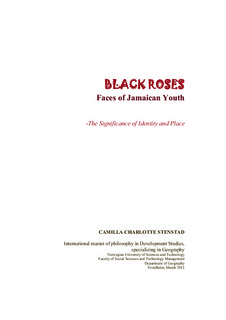| dc.description.abstract | Youth is a contested term which has been described as difficult to define and ‘pin down analytically’ (De Boek and Honwana 2005:3). In much youth development related issues, youth is categorised as a person between the ages of 15-24, which is defining a person only in terms of one’s chronological age. Age is a good indicator of where in life a person is, I used thus a wider range to include also older youth. Youth are often viewed in relation to other social categories as adults or children, and notions of youth are often as becomings, dependent, powerless, rebellious, risky (behaviour) and irresponsible, a focus merely on ‘negative’ aspects of youthhood, are these notions really describing the general youth? This study explores given youth identities in terms of behavioural patterns of being ‘in place’ and/or ‘out of place’. Identities are in this thesis approached as socially constructed, and people can hold multiple identities.
This thesis therefore presents different identity narratives of Jamaican Youth ‘faces’. I used qualitative research methodology to collect and analyse the empirical data generated during fieldwork in Jamaica, Port Antonio in the period of February to beginning of May 2009. Methods such as informal conversations, observations, key informant interviews and photography is the main sources of the collected data, but also secondary data has been used in the analysis to grasp the surrounding realities. The youth participants of this study, 37, are persons who define themselves as youth and are viewed as youth by the Jamaica society based on their activities and behaviour, and are not dependent of their age, gender, class or occupation. In addition twelve (12) adults have contributed to the outsider’s views. The analytical concept of place is used to examine youth’s different behavioural patterns, based on socially accepted activities which are preformed in socially constructed youth places. The social meanings that identity performance have for the sense of being ‘in place’ and belonging to a place are explored to examine how this affects their identity building processes within a specific place. Also outside processes as national youth policy making, media representations and statements from ‘locals’, are evaluated as contributing to the present perceived Jamaican youth identities.
I found multiple constructed ‘faces’of Jamaican youth; ‘the naughty’, ‘the nice’, the sexy’, ‘the wise’ and ‘the runner’ , are presented. These identities are fluid and transferable between different places in society and in time. The participants in this study each hold several of these ‘faces’, but often one which are more prominent in relation to the place one uses at that time. The located youth places; the youth centre place, the marina place and the dancehall place, are sites where the identity building processes takes form and social identities are constructed in relations to the socially acceptable conventions in the places in which youth occupy. These social conventions and identities may be negotiated, modified, reconstructed, challenged, contested or resisted in the ‘never-ending’ identity and place production processes. Identity, which is a complex term, holds several of attributes within categories as gender, race, age ect., but none of these attributes exist alone, and place as a contributor to the identity building processes is in this thesis seen as significant in the dynamic relation to all the attributes a person holds, which are preformed at different scales in society, both to be ‘in place’ and/or ‘out of place’. The youth ‘faces’ in Jamaica are also related and part of the national identity, they should therefore be accepted rather than rejected as ‘unwanted behaviour’, since a person rarely just hold one identity. | nb_NO |
